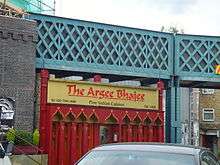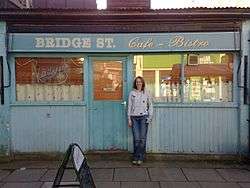Walford
| Walford | |
|---|---|
|
Bridge Street Café before its refurbishment in 2009 | |
| EastEnders location | |
| Created by | Tony Holland & Julia Smith |
| Genre | Soap opera |
| Type | London borough |
| Notable locations | Albert Square |
| Notable characters | EastEnders characters |
Walford is a fictional borough of east London in the BBC soap opera EastEnders. It is the primary setting for the soap.
EastEnders is filmed at Borehamwood in Hertfordshire, towards the north-west of London. Much of the location work is filmed in nearby Watford. It has been suggested that Watford was chosen for much of the exterior scenes due to its close proximity and the town's name being so similar to Walford. Thus, any stray road signs or advertising boards which are accidentally filmed in the back of shots will appear to read Walford. Locations used in Watford include most interior and exterior church scenes of various churches, the snooker club, the County Court and Magistrates' Courts courtrooms, and the cemetery (where most of the deceased characters are interred).
The name Walford is both a street in Dalston where one of the series' creators, Tony Holland, lived and a blend of Walthamstow, where Holland was born, and Stratford.[1] The suffix 'ford' is also found throughout East London, for example, South Woodford.[2] Walford's London postcode district is E20 (real East London postcode districts only went up to E18[3] until 2011, when E20 was introduced to serve the London 2012 Olympic Park[4]). Walford's fictional tube station, Walford East, is located on the EastEnders tube map in the position normally occupied by the real Bromley-by-Bow tube station.[5][6]
As part of 2010 Children In Need charity appeal, Walford became twinned with Weatherfield in a special programme uniting the two soaps EastEnders and Coronation Street called "East Street".
Locations within Walford

.jpg)

The main setting of EastEnders is Albert Square, where many of the characters reside. Central to the Square is the garden. The garden is home to Arthur Fowler's bench, which was placed there in memory of him. The bench is also known as the 'Bench of Tears', as it is often the place where characters will go and cry. One corner of the square is taken up by The Queen Victoria Public House.[7] There is a B&B and a car lot.[7] The square's design was based on Fassett Square in Dalston,[8] and was given the name Albert Square after Prince Albert. The Queen Victoria, was also given its name due to this. [9] The Queen Victoria public house, known to residents as the Queen Vic or simply 'The Vic', stands south of the square at number 45 Albert Square, where it joins with Bridge Street. East of the pub is a building with 2 flats and west of these in the southwest corner leads off to a walkway through to Turpin Way, on which the Walford Community Centre and Playground are found.[7] To the west of the Queen Vic, across the junction with Bridge Street, is the Beale house, 45 Albert Square. Next to that is 43 Albert Square. In the southwest corner of the square is number 41.[7] Between numbers 41 and 43 is Daisy Lane, a pathway connecting Albert Square to Victoria Square. Daisy Lane was named after the daughter of Series Designer Steven Keogh.[2] On the west edge of The Square there are two houses 18 and 20 Albert Square, which have been knocked through as a single property and then later separated again. It was previously Walford's B&B, 'Kim's Palace'. North of the old B&B is the rear of 55 Victoria Road. A row of five terraced houses line the north edge of Albert Square. The westernmost house is number 31. The property next door is split into two flats. Number 25 is the home of Dot Cotton (June Brown). The easternmost property in the terrace is number 23, which was destroyed in September 2014 by a fire.[7][10] On the northeast edge of Albert Square is a car lot, south of which is another terrace of three elevated properties. The northernmost house is number 5. A road leaves to the north at the northeast edge of the square, passing by the car lot. The middle house is 3 Albert Square. Most southerly of this terrace is number 1,[7] originally flats with the doctor's surgery on the ground floor, which later becomes a single house.
Bridge Street is the location of the street market and shops including the café (Staff here include Kathy Beale, Tina Carter, Bex Fowler and Marie) launderette (Staff here have included Dot Branning, Pauline Fowler and Carol Jackson) and mini-supermarket (Staff here have included Yolande Trueman, Heather Trott, Honey Mitchell and Derek Harkinson) . Turpin Road is the location of a war memorial, bookmaker, chip shop, funeral parlour, restaurant and an upmarket bar as well as several other businesses.[7] The nightclub on Turpin Road was originally named The Market Cellar until George Palmer buys it and renames it the Cobra Club. Over the years it becomes e20, Angie's Den, Scarlet and R&R, with owners including Steve Owen (1998–2002), Billy Mitchell (2002–2003), Beppe di Marco (2002), Sharon Rickman (2002–2005, 2013–2014), Den Watts (2004–2005), Johnny Allen (2005–2006), Ruby Allen (2006), Roxy Mitchell (2007, 2010–2011), Ronnie Mitchell (2007–2009, 2010–2012), Jack Branning (2007–2011), Janine Butcher (2011–2013) and Phil Mitchell (2011–present). The name R&R is taken from the initials of Ronnie and Roxy.[7] A major storyline within the club occurs in February 1999, when Saskia Duncan is killed during a struggle with Steve and Matthew Rose. The name Turpin Road was chosen after the show's creators read that the East End was the haunt of notorious highwaymen, such as Dick Turpin.[2]
George Street is the location of an Italian restaurant, Giuseppe's, which later becomes an Indian restaurant, Argee Bhajee, when a new owner takes over. Walford East tube station is on George Street,[7] which first appeared on screen in late 1985 when Lou Beale collapses outside it. On maps seen inside the station it replaces Bromley-by-Bow on the District line, but the building is in the style of those designed by Leslie Green, even though his work only appears on the Bakerloo, Northern, and Piccadilly lines.[11] The train sound was first heard in 1987 and the train's first appearance was in 1988 at Lou Beale's funeral. Trains did not appear again until 4 February 2010, when CGI was used in the show for the first time.[12] Platforms within the station were first seen in 2011 when Charlie Slater (Derek Martin) left Walford.
Turpin Way includes the local garage, informally known as The Arches, the community centre, a playground and a boxing gym.[7] Other locations seen or mentioned in the series include Victoria Square, Walford Towers, Kingsley Road,[13] Spring Lane and the High Street. Storylines in 2017 mentioned the demolition of Walford Towers, as a means of introducing new characters to the series. Walford Common was introduced to the series for the "Who Killed Lucy Beale?" storyline in 2014. Clifton Hill Road was shown as the location for Walford Crematorium in the episode shown on 17 April 2017,[14] while New Street was shown as the address of the veterinary surgery in the episode shown on 24 April 2017.[15]
See also
- EastEnders#Set
- List of fictional railway stations
- List of fictional rapid transit stations
- List of London Underground-related fiction
References
- ↑ Smith 2005.
- 1 2 3 "How was the name Walford chosen?". BBC. Archived from the original on 5 April 2007.
- ↑ "London Postcodes". Flatshare Ltd. Retrieved 5 May 2017.
- ↑ "ROYAL MAIL INTRODUCES NEW E20 POSTCODE FOR THE OLYMPIC PARK". London Legacy Development Corporation. 18 March 2011. Archived from the original on 6 November 2013. Retrieved 5 May 2017.
- ↑ "Underground EastEnders". Underground History. Retrieved 4 November 2009.
- ↑ Eastenders Website
- 1 2 3 4 5 6 7 8 9 10 "Welcome to Albert Square". Inside Soap. 12–18 July 2014.
- ↑ "Interesting Places and Famous Faces". Hackney Borough Council. Archived from the original on 4 March 2016. Retrieved 13 December 2009.
- ↑ "What's the history of the Queen Vic?". BBC. Archived from the original on 20 December 2006.
- ↑ Kilkelly, Daniel. "EastEnders reveals dramatic September storylines". Digital Spy. Retrieved 21 September 2014.
- ↑ Leboff 2002, pp. 92.
- ↑ "Get your anoraks on... trains are coming!". BBC Online. 3 February 2010. Retrieved 4 February 2010.
- ↑ "Lucy Beale Case File – Evidence: Funeral". EastEnders. BBC Online. Retrieved 18 July 2014.
- ↑ Executive Producer: Sean O'Connor; Director: Lance Kneeshaw; Writer: Daran Little (17 April 2017). "Episode dated 17/04/2017". EastEnders. BBC. BBC One.
- ↑ Executive Producer: Sean O'Connor; Director: John Greening; Writer: Natalie Mitchell (24 April 2017). "Episode dated 24/04/2017". EastEnders. BBC. BBC One.
Bibliography
External links
| Wikimedia Commons has media related to EastEnders sets. |
- BBC map of Walford via Internet Archive
- Underground EastEnders Information on Walford East
- Fassett Square, "The original inspiration for EastEnders"
